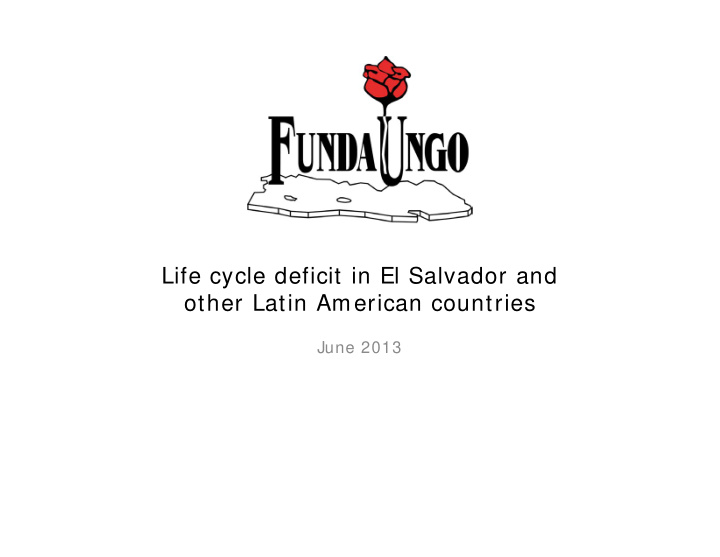



Life cycle deficit in El Salvador and other Latin American countries June 2013
To estimate Life Cycle Deficit it was used NTA Methodology to some of latinamerican countries Life Cycle Deficit (LCD) • Estimated to El Salvador (2010) and compared to Costa Rica (2004), Mexico (2004), Uruguay (2006), Brazil (2002), Chile (1997) Methodology NTA • Allocate to every individual, through de micro data, the amount of resources correspondent • Estimate the single age profile for each variable • Adjust the profile to the macro data reported in National Accounts Data used to estim ate El Salvador LCD its prelim inary due to lack of official data Data source NTA web site: http: / / www.ntaccounts.org/ web/ nta/ show/ .
Agenda Introduction Consumption and its components – Public and private consumption Labor income and its components – Earnings and self employment labor income Life cycle deficit Conclusion
Public consumption in the early ages is largely defined by public consumption in education Education Public Consumption • El Salvador (2010), Costa Rica (2004), Mexico (2004), Brazil (2002), Chile (1997) & Uruguay (2006) Source: Authors' calculations based on Córdova et al (2012) and estimations of nationals NTA teams, various years.
Public consumption on health in the early and late ages is significant in all countries Health Public Consumption • El Salvador (2010), Costa Rica (2004), México (2004), Brazil (2002), Chile (1997) & Uruguay (2006) Source: Authors' calculations based on Córdova et al (2012) and estimations of nationals NTA teams, various years.
Public consumption shows a pattern that is closely associated with age Other Public Consumption • Other than education and health & total public consumption • El Salvador (2010), Costa Rica (2004), México (2004), Brazil (2002), Chile (1997) & Uruguay (2006) Source: Authors' calculations based on Córdova et al (2012) and estimations of nationals NTA teams, various years.
In El Salvador, education is funded largely by the private Education Private Consumption • El Salvador (2010), Costa Rica (2004), Mexico (2004), Brazil (2002), Chile (1997) & Uruguay (2006) Source: Authors' calculations based on Córdova et al (2012) and estimations of nationals NTA teams, various years.
Private consumption in health is larger in Uruguay than the other countries compare Health Private Consumption • El Salvador (2010), Costa Rica (2004), Mexico (2004), Brazil (2002), Chile (1997) & Uruguay (2006) Source: Authors' calculations based on Córdova et al (2012) and estimations of nationals NTA teams, various years.
Private consumption peaks in the ages at which the individual is more productive Other Private Consumption • Other than education and health & total private consumption • El Salvador (2010), Costa Rica (2004), México (2004), Brazil (2002), Chile (1997) & Uruguay (2006) Source: Authors' calculations based on Córdova et al (2012) and estimations of nationals NTA teams, various years.
Private consumption is the largest component (74% ) of total consumption Total Public & Private Consumption • El Salvador (2010), Costa Rica (2004), México (2004), Brazil (2002), Chile (1997) & Uruguay (2006) Source: Authors' calculations based on Córdova et al (2012) and estimations of nationals NTA teams, various years.
Agenda Introduction Consumption and its components – Public and private consumption Labor income and its components – Earnings and self employment labor income Life cycle deficit Conclusion
In El Salvador and Mexico earnings are comparatively lower than those experimented by the other countries Earnings Labor Income • El Salvador (2010), Costa Rica (2004), Mexico (2004), Brazil (2002), Chile (1997) & Uruguay (2006) Source: Authors' calculations based on Córdova et al (2012) and estimations of nationals NTA teams, various years.
El Salvador and Mexico present the higher level of self-employment income Self Labor Income Em ploym ent • El Salvador (2010), Costa Rica (2004), Mexico (2004), Brazil (2002), Chile (1997) & Uruguay (2006) Source: Authors' calculations based on Córdova et al (2012) and estimations of nationals NTA teams, various years.
The maximun self-employment income is reached later in life than earnings Labor Income Max levels • El Salvador (2010), Costa Rica (2004), Mexico (2004), Brazil (2002), Chile (1997) & Uruguay (2006) Earnings Self ‐ Employment Country Max Max El Salvador 38 50 Costa Rica 42 48 México 41 47 Uruguay 42 54 Chile 35 48 Brasil 44 51 Source: Authors' calculations based on Córdova et al (2012) and estimations of nationals NTA teams, various years.
Income from self-employment has a large share of total labor income in El Salvador and Mexico Labor Income and its Components • El Salvador (2010), Costa Rica (2004), México (2004), Brazil (2002), Chile (1997) & Uruguay (2006) Source: Authors' calculations based on Córdova et al (2012) and estimations of nationals NTA teams, various years.
Agenda Introduction Consumption and its components – Public and private consumption Labor income and its components – Earnings and self employment labor income Life cycle deficit Conclusion
For El Salvador lifecycle deficit has only positive values Life Cycle Deficit • El Salvador (2010), Costa Rica (2004), México (2004), Brazil (2002), Chile (1997) & Uruguay (2006) Source: Authors' calculations based on Córdova et al (2012) and estimations of nationals NTA teams, various years.
Agenda Introduction Consumption and its components – Public and private consumption Labor income and its components – Earnings and self employment labor income Life cycle deficit Conclusion
In the case of El Salvador the life cycle deficit has only positives values Main Conclusions • In the period of greatest productivity and highest labor income, public consumption tends to be relatively low. • Private consumption represents 74% of total consumption for all the countries analyzed • Self-employment income has a big importance in El Salvador (37% of total labor income) and Mexico (34.8% of total labor income) • For El Salvador consumption is always higher than labor income regardless of age • An hypothesis that could explain this is that the important flow of remittances (16% of GDP) received by households sustain the high level of consumption compared to labor income
Recommend
More recommend